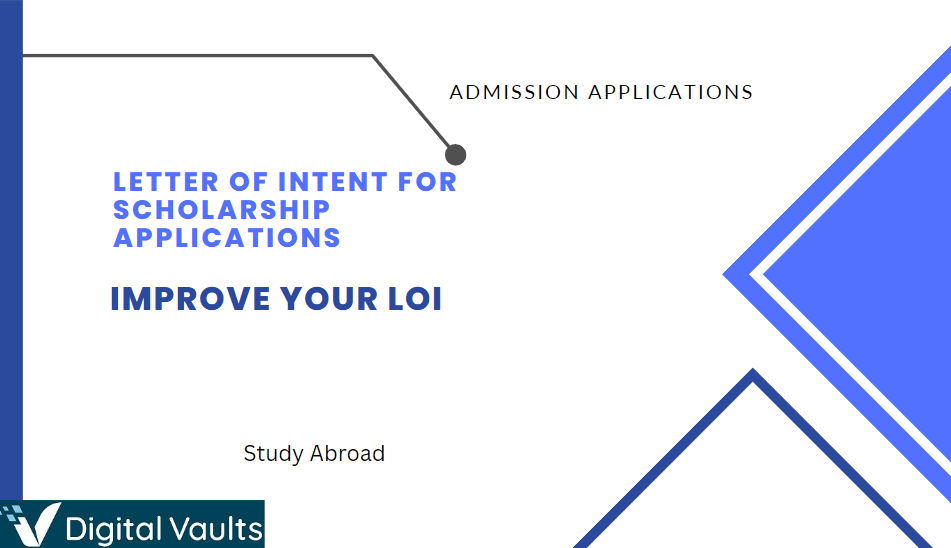Letter of Intent for a Scholarships or Admission ApplicationApril 17, 2024 by Digital Vaults Editorial Team
A letter of intent for a scholarship should be written and formatted just the right way to get the judges’ attention, who will decide if you’re awarded money to pursue your academic goals. If you don’t have experience writing letters of intent, here’s how to write one that stands out from the crowd!

What is an Letter Of Intent (LOI)?
An LOI is an official letter outlining your intent to pursue a scholarship. It can be written as an email or in the form of a formal letter. The LOI should include information about why you are interested in the scholarship, any relevant experience, and qualifications that make you a strong candidate. In addition, have where you will be attending school, what major/program you are pursuing, and when they can expect to hear back from you regarding whether or not they have offered you the scholarship. If they have awarded it already, let them know how much time they should allot before making their final decision.
Why should you submit an LOI?
To be eligible to win a scholarship, you’ll need to submit an LOI. An LOI is the first step in the application process. It shows your intent to apply for that scholarship and helps you establish your eligibility by providing some basic information about yourself. By submitting an LOI, you’re taking the initiative and setting yourself apart from other applicants who haven’t yet submitted one.
Who should apply for a scholarship with an LOI?
People applying to graduate or professional schools may also need to write an LOI to compete with other applicants. An LOI can be used as a template when writing your letter so that you know what you should include. These letters are often more formal than personal letters because they are written to an institution rather than an individual. As such, there is less room for individuality, and the tone will usually be one of gratitude.
What do I need to know before writing the LOI?
Before writing your letter of intent, you should know that: – Letters of intent are usually written in response to an invitation to submit one. – Letters of intent are usually 2-3 pages long. – Letters of intent should mention why you’re qualified and what you can offer the scholarship organization. – Letters of intention tend to be personal and not require a formal tone.
You may want to show some personality with this letter. Now is the time if you’ve done anything interesting or have any remarkable story to tell. Remember that letters of intent are meant as introductory documents before a potential candidate is chosen; they’re not used to assess eligibility or qualifications. So it doesn’t need to be wordy or high-browed. Instead, it needs to introduce yourself in a way that makes you sound like someone who would greatly use their scholarship if given a chance.
Step-by-step guide on writing your letter of intent
- Start by introducing yourself and telling the scholarship committee why you are interested in their scholarship. For example, I am currently enrolled at ____ University, pursuing my degree in ____.
- Provide information about your academic background and extracurricular activities to show that you are an engaged student with an active interest in your field of study. For example, I have been awarded both undergraduate and graduate scholarships from ____ University for my involvement in _______. In addition, my time has also been spent teaching younger students the basics of computer programming through the local school system. As such, I believe I would be an excellent candidate for this scholarship because I am committed to supporting education in all forms.
- Briefly outline what you need or want from the scholarship: The funds could be used towards tuition, living expenses, or travel costs associated with attending conferences or workshops related to my studies.
- End your letter on a strong note: Thank you again for considering me as one of the recipients of this scholarship! Don’t hesitate to contact me if you have any questions.
Sincerely yours, _________
- Finish off with a formal closing: I look forward to hearing from you soon. If you have any other questions, please don’t hesitate to contact me at (XXX) XXX-XXXX. Regards, __________
- Send your letter electronically to the address provided on their website, and cross your fingers!
- And finally, don’t forget to keep copies of everything so you can refer back to them later if necessary! 8. Once you’ve completed these steps, submit your letter and wait patiently for the response!
- Be sure to follow up if they say they’ll get back to you within a certain period. If you haven’t heard anything, try calling them or sending another email.
- If they offer feedback on your application before rejecting it, consider what they said before submitting another application elsewhere.
- You may find that this leads to more opportunities in the future, whether that means applying for other scholarships or networking with new people who might help you down the line!
- Don’t give up hope just yet; sometimes, things work out when we least expect it!
The scholarship letter of intent contains the following parts
> The letterhead: The first and foremost thing that your letter should have is information about you, including your name, address, and contact information.
> Introducing yourself and your educational goals: Introduce yourself to the scholarship committee by mentioning why you are applying for the scholarship and your educational purposes. Be sure to mention any circumstances that may have hindered you from reaching these goals in the past and how this particular scholarship will help you overcome these obstacles.
You might also want to mention any awards or honors you’ve won or even an instance where you helped someone else who was in need. The introduction should be brief, but it should include everything the scholarship committee needs to know about your background so they can make an informed decision about awarding you a scholarship.
> A record of previous academic achievement: Your letter should then go on to explain any accomplishments or achievements you’ve made at school so far, such as making the honor roll, participating in extracurricular activities, and maintaining good grades. Show the scholarship committee that their money will not go to waste if they award you a scholarship because you’ll most likely use it wisely and responsibly.
> Experience and skills related to working: Talk about any experience or skills you have that would relate to the field of work the scholarship is intended for. For example, if you’re applying for a photography scholarship, mention how much you love taking pictures and working with photography equipment like cameras, lights, etc. If applying for a journalism scholarship, mention your experience interviewing people in public places.
If you’re applying for a culinary arts scholarship, talk about your experience cooking for large groups of people or cooking with fresh ingredients. For example, one could say something like as someone interested in culinary arts, I have had many opportunities to cook using fresh produce, which has led me to develop my palate. If you’re unsure whether or not any particular skill or experience would count as being relevant to the scholarship application process, ask the scholarship administrator before writing your letter.
> Objectives for the long term and the short term: The last paragraph of your letter of intent should describe the objectives you plan to accomplish both in the near future (within five years) and the distant future (more than five years). These objectives should align with what you wrote about your academic performance and life experiences. For example, if you mentioned that you wanted to attend graduate school when discussing your academic performance earlier in the letter, then your objective for the distant future would state something along those lines.
What should not be in a scholarship letter of intent?
It is essential to avoid the following when writing your letter of intent:
-Do not refer to the scholarship as scholarship money. This sounds like begging or asking for charity.
-Do not use flattery or exaggeration. Be honest about who you are and why you deserve this scholarship.
-If you are not being truthful in your letter, it will be easier to see through during the interview process. You must convince the scholarship committee that they should choose you over all other applicants. You want them to believe that they will be helping someone who deserves a chance at higher education by choosing them.
-You should also ensure that your letter has a strong opening and ending statement so it leaves an impression on the reader. These statements might include your gratitude for their consideration, what sets you apart from other candidates, or how much you would appreciate receiving this award. As always, make sure your scholarship letter ends with a thank you.
-Make sure you proofread your work before sending it out because typos can hurt your chances of winning.
-Finally, there is no right way to write a letter of intent; do what works best for you!
A sample scholarship letter of intent
Dear Mr. /Ms. ____,
I am applying to be the recipient of your prestigious scholarship. I have always been interested in _____ and am excited to study the field further. My academic experience has been centered around _____, and I have found that this is what I want to do with my life.
I believe that I would be a valuable addition to your program because _____. If given this opportunity, it will not only help me grow as an individual but also allow me to share my knowledge with others and improve society as a whole. I appreciate you reading this letter. I hope to hear from you soon.
Sincerely,
ABC
Finally!
There you have it, how to write an effective letter of intent. By using these tips, you will be well on your way to creating a successful scholarship application. Good luck and happy writing!
https://digitalvaults.org/list-of-scholarship-documents/



